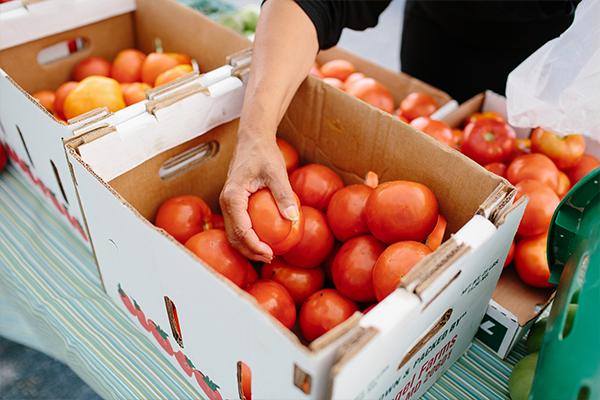Is your family in balance?
Studies have shown that those who consume more fruits and vegetables while decreasing their consumption of fat and added sugar manage weight better, are less hungry and have better intake of other nutrients such as vitamins and minerals. For more information on how fruits, vegetables and exercise can help you manage your weight, download the "Is Your Family in Balance?" tip card.
Build a healthy plate.
Before you eat, think about what goes on your plate or in your bowl. Foods like vegetables, fruits, whole grains, low-fat dairy products and lean protein foods contain the nutrients you need without too many calories. Over the day, include foods from all the food groups. Use MyPlate as a tool to keep your meals balanced.
Be sure to eat plenty of fruits and vegetables.
Adults should eat at least 4½ cups of fruits and vegetables a day, especially those rich in vitamins A and C. Variety is important when it comes to fruits and vegetables. Think of eating fruits and vegetables like eating the rainbow. Be sure to sample all the colors as often as you can.
- Orange and Deep Yellow: Try sweet potatoes, carrots, winter squash, oranges, peaches, yellow tomatoes, mango, papaya, pineapple and cantaloupe.
- Red: Try tomatoes, pink grapefruit and watermelon.
- Green: Try spinach, collards, turnip greens, kiwi, green bell pepper, zucchini and sugar snap peas.
- Purple, Dark Red and Blue: Try beets, blueberries, red and purple grapes, cherries and eggplant.
- White: Try cauliflower, parsnips and turnips.
Check out these resources for increasing your vegetables and fruits:
- Liven up Your Meals with Vegetables and Fruits — Tips to improve your meals with vegetables and fruits.
- Add More Vegetables to Your Day — Tips to help you eat more vegetables.
- Storing Fresh Fruits and Vegetables for Best Flavor — A guide to storing fruits and vegetables.
- Maryland’s Best Agriculture — Find farms and farmers’ markets near you.
What Does ‘Organic’ Mean on a Food Label? —The term organic has specific guidelines defined by the United States Department of Agriculture’s (USDA) National Organic Program.
Increase the fiber in your usual diet.
Besides fruits and vegetables, whole grain breads and cereals are good sources of fiber. Check out “10 Tips to Help You Eat Whole Grains” for tips on making half your grains whole.
Lower the fat, especially trans fat.
Try to reduce the fat you eat by choosing lean meat, fish, skinned poultry, low-fat dairy products and vegetable oils. Avoid fried foods and those cooked with butter and oil. When dining out, look for low-fat menu options, or ask whether food can be baked or broiled instead of fried. For more information, download the following:
- How Can I Lower High Cholesterol? – Tips for choosing low fat and low cholesterol foods.
Too Much Sodium (Salt) Is Not Good For Your Heart.
The Dietary Guidelines for Americans recommends adults limit sodium intake to less than 2,300 mg per day—that’s equal to about 1 teaspoon of table salt. For children under age 14, recommended limits are even lower. Too much sodium increases a person’s risk for high blood pressure which often leads to heart disease and stroke. Most of the sodium we eat comes from processed foods and foods prepared at restaurants. It is important to select lower sodium foods when possible and cook more food yourself so you can better control how much sodium you eat.
Eating Healthy When Eating Out by MyPlate.gov.
- Choose restaurants that offer fruits and vegetables on the menu.
- At sit down restaurants, order salad and cooked vegetables as part of your meal. Ask if vegetables or salad can be substituted for French fries. Order fresh fruit for dessert.
- At fast food restaurants, order a small 100% orange juice, milk or water instead of soft drinks. Substitute a baked potato for fries. Add lettuce and tomato to sandwiches. Use the salad bar and go easy on the dressing. Order the chili. Try the fruit parfait in place of the apple pie.
Get more for your money.
Careful meal planning and smart shopping can help you make the most out of your family’s budget. Check out the “Getting More For Your Money” tip card for tips on getting the most for your money when buying fruits and vegetables.
- Eating Better On a Budget — For 10 tips to help you stretch your food dollar.
For additional tips on spending smart and eating smart, download the information below for each food group.
Information provided by the Iowa State University Extension.
- Spend Smart Eat Smart website — For more tips, recipes, quizzes and cost comparisons.
- Vegetables
- Dairy
- Fruits
- Protein
- Grains
Additional Information
Visit these websites for more information about keeping your family healthy.
- National Heart, Lung and Blood Institute
- U.S. Department of Agriculture, Center for Nutrition Policy and Promotion
- American Cancer Society
- U.S. Food and Drug Administration
- American Heart Association
- Academy of Nutrition and Dietetics
- MyPlate.gov
- Fruits and Veggies More Matters

